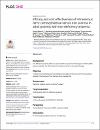Efficacy and cost effectiveness of intravenous ferric carboxymaltose versus iron sucrose in adult patients with iron deficiency anaemia

View/
Date
2021Author
Basha, AhmadIbrahim, Mohamed Izham Mohamed
Hamad, Anas
Chandra, Prem
Omar, Nabil E.
Abdullah, Mohamed Abdul Jaber
Aldapt, Mahmood B.
Hussein, Radwa M.
Mahfouz, Ahmed
Adel, Ahmad A.
Shwaylia, Hawraa M.
Ekeibed, Yaslem
AbuMousa, Rami
Yassin, Mohamed A.
...show more authors ...show less authors
Metadata
Show full item recordAbstract
Background Iron deficiency anaemia (IDA) is a major health issues and common type of nutritional deficiency worldwide. For IDA treatment, intravenous (IV) iron is a useful therapy. Objective To determine the efficacy and cost-effectiveness (CE) of intravenous (IV) Ferric Carboxymaltose (FCM) versus IV Iron Sucrose (IS) in treating IDA. Data sources Electronic medical record i.e. Cerner system. Target population Adults patients with iron deficiency anaemia. Time horizon A 12-month period (01/01/2018-31/12/2018). Perspective Hamad Medical Corporation (HMC, a public hospital). Intervention IV Ferric Carboxymaltose versus IV Iron Sucrose. Outcome measures With regard to responses to treatment i.e., efficacy of treatment with FCM & IS in IDA patients, hemoglobin (Hgb), ferritin, and transferrin saturation (TSAT) levels were the primary outcomes. Additionally, the researchers also collected levels of iron, platelet, white blood cell (WBC), red blood cell (RBC), mean corpuscular hemoglobin (MCH), and mean corpuscular volume (MCV). The costs i.e. resources consumed (obtained from NCCCR-HMC) and the CE of FCM versus IS were the secondary outcomes. Results of base-case analysis There was a significant improvement in Hgb, RBC and MCH levels in the IS group than the FCM group. The overall cost of IS therapy was significantly higher than FCM. The medication cost for FCM was approximately 6.5 times higher than IS, nonetheless, it is cheaper in terms of bed cost and nursing cost. The cost effectiveness (CE) ratio illustrated that FCM and IS were significantly different in terms of Hgb, ferritin and MCH levels. Further, Incremental Cost Effectiveness Ratio (ICER) indicated that further justifications and decisions need to be made for FCM when using Hgb, iron, TSAT, MCH and MCV levels as surrogate outcomes. Results of sensitivity analysis Not applicable. Limitations The study did not consider the clinical or humanistic outcome. Conclusions The higher cost of FCM versus IS can be offset by savings in healthcare personnel time and bed space. ICER indicated that further justifications and decisions need to be made for FCM when using Hgb, iron, TSAT, MCH and MCV levels as surrogate outcomes.
Collections
- Pharmacy Research [1444 items ]

